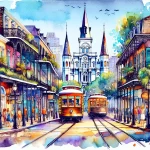New Orleans encounters a distinct rainy period that is a defining characteristic of its subtropical climate. With an average annual rainfall exceeding 60 inches, the city is familiar with wet conditions, but the months from June through November are particularly prone to heavy precipitation and thunderstorms.
In This Article
TL;DR
- The peak rainy season in New Orleans occurs from July to August, typically lasting from June to November.
- The city’s proximity to the Gulf of Mexico and its low elevation contribute to increased rainfall during these months.
- Understanding the rainy season is essential for visitors planning activities and locals preparing for potential flooding and disruptions.
Understanding the Rainy Season: Timing and Weather Patterns
The rainy season in New Orleans typically begins in June and extends through November, with the peak occurring in July and August. During these months, the city experiences frequent thunderstorms, heavy downpours, and high humidity levels.
The primary factor contributing to the rainy season is the city’s proximity to the warm waters of the Gulf of Mexico. As the Gulf heats up during the summer months, it fuels the formation of thunderstorms and tropical systems that bring copious amounts of rainfall to the region. Additionally, New Orleans’ low elevation, with much of the city lying below sea level, makes it particularly susceptible to flooding during periods of heavy rain.
Compared to other times of the year, the rainy season in New Orleans sees a significant increase in both the frequency and intensity of rainfall events. While the city experiences an average of 5-6 inches of rain per month during the drier months, this figure can double or even triple during the peak of the rainy season.
Impact of Rainy Season on Local Life and Culture
The rainy season in New Orleans is deeply ingrained in the city’s culture and daily life. Locals have adapted to the frequent downpours by embracing a laid-back attitude and finding creative ways to cope with the wet weather.
One notable adaptation is the prevalence of covered walkways and balconies in the city’s architecture, providing shelter from the rain while allowing residents to continue their daily activities. Additionally, the use of umbrellas and rain boots is a common sight during the rainy season, with many locals keeping a spare set in their vehicles or workplaces.
The rainy season has also influenced the local arts, music, and culinary scenes. Jazz musicians often incorporate the rhythmic sounds of raindrops into their performances, while artists capture the city’s moody atmosphere in their paintings and photographs. Comfort foods like gumbo and jambalaya, which can simmer for hours, are particularly popular during the rainy months, providing warmth and sustenance on dreary days.
Planning Activities During the Rainy Season
Visitors to New Orleans during the rainy season should expect frequent showers and thunderstorms, often accompanied by high humidity and occasional street flooding. However, with proper planning and preparation, there are numerous indoor and covered activities that can be enjoyed during this time.
The city’s rich cultural heritage is on full display at museums like the National World War II Museum, the New Orleans Museum of Art, and the Ogden Museum of Southern Art, all of which offer respite from the rain while providing educational and enriching experiences.
For those seeking culinary adventures, cooking classes at establishments like the New Orleans School of Cooking or Crescent City Cooks offer hands-on opportunities to learn the art of Creole and Cajun cuisine in a cozy, indoor setting.
Additionally, visitors can explore the city’s vibrant music scene by attending live performances at iconic venues like Preservation Hall or catching a show at one of the many jazz clubs lining Frenchmen Street.
When planning activities during the rainy season, it’s essential to pack appropriate attire, such as lightweight, water-resistant clothing and comfortable walking shoes. Carrying an umbrella or poncho is also recommended, as sudden downpours can occur without warning.
Seasonal Events and Festivals During the Rainy Season
Despite the wet weather, New Orleans continues to celebrate its rich cultural heritage with a variety of events and festivals during the rainy season. One of the most notable is the Satchmo SummerFest, held annually in early August to honor the life and legacy of jazz legend Louis Armstrong.
This three-day festival features live music performances, seminars, and a second-line parade through the historic Treme neighborhood. While outdoor activities may be affected by rain, the festival’s indoor venues and tented stages provide ample opportunities to enjoy the festivities while staying dry.
Another popular event is the New Orleans Seafood Festival, typically held in early September. This celebration of the city’s renowned seafood cuisine features cooking demonstrations, live music, and a wide array of local vendors offering fresh catches and Cajun-inspired dishes. Attendees can seek shelter from the rain under the festival’s covered areas and tents while indulging in the flavors of the Gulf Coast.
When attending these events during the rainy season, it’s advisable to check the forecast and plan accordingly. Wearing comfortable, waterproof footwear and carrying a lightweight poncho or umbrella can help ensure an enjoyable experience, rain or shine.
Historical Perspectives on Rainy Seasons in New Orleans
New Orleans’ history is inextricably linked to its rainy seasons and the challenges posed by heavy rainfall and flooding. One of the most significant events was the Great Mississippi Flood of 1927, which inundated vast areas of the city and surrounding regions, displacing hundreds of thousands of people and causing widespread devastation.
In the aftermath of this catastrophic event, the city embarked on a massive infrastructure project to construct a comprehensive system of levees, floodwalls, and drainage pumps to better protect against future flooding. This effort was spearheaded by influential figures like Leander Perez, a powerful political boss who played a pivotal role in securing funding and overseeing the construction efforts.
More recently, Hurricane Katrina in 2005 exposed the vulnerabilities of New Orleans’ flood protection systems, leading to widespread flooding and loss of life. This event prompted a renewed focus on improving the city’s resilience to extreme weather events, with initiatives such as the Gentilly Resilience District aimed at implementing sustainable drainage solutions and green infrastructure.
Safety and Emergency Preparedness
During the rainy season in New Orleans, it’s crucial to prioritize safety and be prepared for potential emergencies. Heavy rainfall can lead to flash flooding, which can be particularly dangerous in low-lying areas and underpasses.
Residents and visitors alike should stay informed about weather advisories and follow any evacuation orders issued by local authorities. It’s also advisable to have an emergency kit on hand, containing essential supplies like non-perishable food, water, first-aid materials, and a battery-powered radio.
In the event of severe weather or flooding, the city’s emergency services, including the New Orleans Fire Department and the New Orleans Emergency Medical Services, are well-equipped to respond and provide assistance. Additionally, organizations like the American Red Cross and the Salvation Army often establish shelters and provide aid during times of crisis.
Enhancing Your Experience: Tips and Tricks
While the rainy season in New Orleans can present challenges, it also offers unique opportunities to fully immerse oneself in the city’s vibrant culture and atmosphere. One way to embrace the rainy ambiance is by indulging in local cuisine and music.
Many of the city’s renowned restaurants, such as Galatoire’s and Commander’s Palace, offer cozy indoor dining experiences that are perfect for savoring classic Creole dishes like shrimp remoulade or turtle soup while listening to the patter of raindrops outside.
For music lovers, attending a performance at one of New Orleans’ intimate jazz clubs, like the Maple Leaf Bar or Snug Harbor Jazz Bistro, can be a truly memorable experience during the rainy season. The intimate settings and soulful melodies create a warm and inviting atmosphere, providing a respite from the wet weather outside.
Additionally, visitors can capture the city’s unique charm during the rainy season by exploring the French Quarter’s narrow streets and courtyards, where the sound of rain on cobblestones and the scent of blooming jasmine create a truly enchanting ambiance.
By embracing the rainy season and seeking out these unique experiences, visitors can fully immerse themselves in the rich culture and atmosphere that make New Orleans such a captivating destination, rain or shine.






